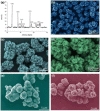Titanium dioxide-based anode materials for lithium-ion batteries: structure and synthesis
- PMID: 36505712
- PMCID: PMC9682492
- DOI: 10.1039/d2ra05442f
Titanium dioxide-based anode materials for lithium-ion batteries: structure and synthesis
Abstract
Lithium-ion batteries (LIBs) have high energy density, long life, good safety, and environmental friendliness, and have been widely used in large-scale energy storage and mobile electronic devices. As a cheap and non-toxic anode material for LIBs, titanium dioxide (TiO2) has a good application prospect. However, its poor electrical conductivity leads to unsatisfactory electrochemical performance, which limits its large-scale application. In this review, the structure of three TiO2 polymorphs which are widely investigated are briefly described, then the preparation and electrochemical performance of TiO2 with different morphologies, such as nanoparticles, nanowires, nanotubes, and nanospheres, and the related research on the TiO2 composite materials with carbon, silicon, and metal materials are discussed. Finally, the development trend of TiO2-based anode materials for LIBs has been briefly prospected.
This journal is © The Royal Society of Chemistry.
Conflict of interest statement
There are no conflicts to declare.
Figures









Similar articles
-
TiO2-Coated Silicon Nanoparticle Core-Shell Structure for High-Capacity Lithium-Ion Battery Anode Materials.Nanomaterials (Basel). 2023 Mar 23;13(7):1144. doi: 10.3390/nano13071144. Nanomaterials (Basel). 2023. PMID: 37049238 Free PMC article.
-
Carbon-Coated Tin-Titanate derived SnO2/TiO2 nanowires as High-Performance anode for Lithium-Ion batteries.J Colloid Interface Sci. 2024 May;661:888-896. doi: 10.1016/j.jcis.2024.02.015. Epub 2024 Feb 5. J Colloid Interface Sci. 2024. PMID: 38330661
-
A Review of Design Strategies in SiO/C Composite Anodes for Rechargeable Lithium-Ion Batteries.Chempluschem. 2024 Oct;89(10):e202400240. doi: 10.1002/cplu.202400240. Epub 2024 Aug 19. Chempluschem. 2024. PMID: 38949230 Review.
-
MOF-Templated Synthesis of Co3O4@TiO2 Hollow Dodecahedrons for High-Storage-Density Lithium-Ion Batteries.ACS Omega. 2019 Aug 2;4(8):13241-13249. doi: 10.1021/acsomega.9b01405. eCollection 2019 Aug 20. ACS Omega. 2019. PMID: 31460451 Free PMC article.
-
"Fast-Charging" Anode Materials for Lithium-Ion Batteries from Perspective of Ion Diffusion in Crystal Structure.ACS Nano. 2024 Jan 30;18(4):2611-2648. doi: 10.1021/acsnano.3c08712. Epub 2024 Jan 14. ACS Nano. 2024. PMID: 38221745 Review.
Cited by
-
Investigation of N C and B C bilayers as anode materials for Li-ion batteries by first-principles calculations.Sci Rep. 2024 May 16;14(1):11180. doi: 10.1038/s41598-024-61939-x. Sci Rep. 2024. PMID: 38755241 Free PMC article.
-
Functionalization of Nanomaterials for Energy Storage and Hydrogen Production Applications.Materials (Basel). 2025 Feb 10;18(4):768. doi: 10.3390/ma18040768. Materials (Basel). 2025. PMID: 40004296 Free PMC article. Review.
-
Nonporous TiO2@C microsphere with a highly integrated structure for high volumetric lithium storage and enhance initial coulombic efficiency.Sci Rep. 2024 Dec 28;14(1):31029. doi: 10.1038/s41598-024-82179-z. Sci Rep. 2024. PMID: 39730721 Free PMC article.
-
Engineering of Metal-Organic Framework-Derived CoTiO3 Micro-Prisms for Lithium-Ion Batteries.Molecules. 2024 Dec 26;30(1):34. doi: 10.3390/molecules30010034. Molecules. 2024. PMID: 39795092 Free PMC article.
-
Nanoarchitectonics for structural tailoring of yolk-shell architectures for electrochemical applications.Sci Technol Adv Mater. 2024 Oct 29;25(1):2420664. doi: 10.1080/14686996.2024.2420664. eCollection 2024. Sci Technol Adv Mater. 2024. PMID: 39539602 Free PMC article. Review.
References
-
- Liu H. S. Bi Z. H. Sun X.-G. Unocic R. R. Paranthaman M. P. Dai S. Brown G. M. Adv. Mater. 2011;23:3450–3454. - PubMed
-
- Chen J. S. Lou X. W. Small. 2013;9:1877–1893. - PubMed
-
- Chen J. B. Zhao H. L. Chen N. Wang X. C. Wang J. Zhang R. Jin C. Q. J. Power Sources. 2012;200:98–101.
-
- Yang S. B. Feng X. L. Müllen K. Adv. Mater. 2011;23:3575–3579. - PubMed
-
- Choi S. I. Jung E.-J. Park M. Shin H.-S. Huh S. Won Y. S. Appl. Surf. Sci. 2020;508:145237.
Publication types
LinkOut - more resources
Full Text Sources
Research Materials

